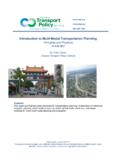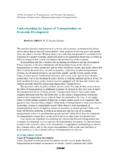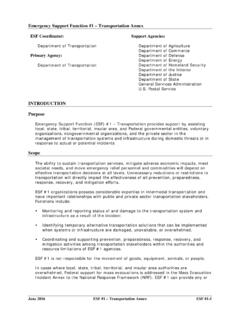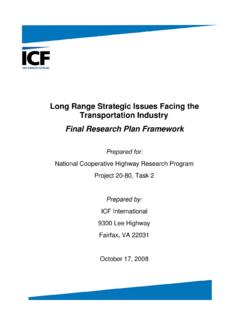Transcription of Transportation and Sustainability Best Practices Background
1 1 Figure 1 Triple Bottom Line of Sustainability FIGURE 1 Triple Bottom Line of Sustainability Sustainability Peer Exchange Center for Environmental Excellence by AASHTO May 27-29, 2009 Transportation and Sustainability best Practices Background Prepared by CH2M HILL and Good Company for the Center for Environmental Excellence by AASHTO Transportation and Sustainability Peer Exchange May 27-29, 2009, Gallaudet University Kellogg Center Introduction Global concerns about climate change, energy use, environmental impacts, and limits to financial resources for Transportation infrastructure require new and different approaches to planning , designing, constructing, operating, and maintaining Transportation solutions and systems.
2 This memorandum provides Background about key leading Practices and methods that Transportation professionals are using to address Sustainability issues relating to Transportation . Defining Sustainability What is Sustainability ? Sustainability is a big concept like justice or freedom and like these concepts, it can be easier to understand than to succinctly define. However hundreds of definitions do exist and most share similar tenets. One oft-quoted definition states that sustainable development meets the needs of the present without compromising the ability of future generations to meet their own needs. (United Nations World Commission on Environment and Development (Brundtland Commission) Report Our Common Future, 1987).
3 Sustainability can also be defined as: An overarching conceptual framework that describes a desirable, healthy, and dynamic balance between human and natural systems. A system of policies, beliefs, and best Practices that will protect the diversity and richness of the planet s ecosystems, foster economic vitality and opportunity, and create a high quality of life for people. A vision describing a future that anyone would want to inhabit. Central to these definitions is Sustainability s applicability to three elements of life: economic or financial considerations, environmental protection and stewardship, and community and individual human well-being the triple bottom line of Sustainability (see Figure 1).
4 This 2 means improving the economic and social quality of life while limiting impacts on the environment to the carrying capacity of nature. In this framework, ideal solutions to any type of challenge will generate long-term benefits in all three areas. Scientists, economists, governments and business acknowledge that current and predicted imbalances in natural systems (such as fresh water shortages, energy supply limits, global climate change, and population increases) will adversely affect economic systems and human quality of life if not addressed. Sustainability is a powerful approach for examining these issues; consequently, it is attracting serious attention by leaders of nations, industry and communities.
5 The number of Sustainability -related trends such as global water needs, changes in global climate, and energy demands has created an uncertain business environment in which new issues, legislation, stakeholder expectations, and technologies must be considered. Definition of Sustainable Transportation The University of Plymouth Centre for Sustainable Transport provides a widely accepted definition of a sustainable Transportation system that states: A sustainable Transportation system is one that: allows the basic access needs of individuals and societies to be met safely and in a manner consistent with human and ecosystem health, and with equity within and between generations; is affordable, operates efficiently, offers choice of transport mode, and supports a vibrant economy.
6 Limits emissions and waste within the planet s ability to absorb them, minimizes consumption of non-renewable resources to the sustainable yield level, reuses and recycles its components, and minimizes the use of land and the production of noise. Such Sustainability improvements around Transportation may not be achieved quickly. However, using a Triple Bottom Line framework to guide planning , policy decisions, and implementation can provide steps toward developing a sustainable outcome. When thinking about delivering Transportation solutions and infrastructure in a more sustainable manner, agencies and companies are considering each of the bottom line elements: Economy Support economic vitality while developing infrastructure in a cost-efficient manner.
7 Costs of infrastructure must be within a society s ability and willingness to pay. User costs, including private costs, need to be within the ability of people and households to pay for success. Social Meet social needs by making Transportation accessible, safe, and secure; include provision of mobility choices for all people (including people with economic disadvantages); and develop infrastructure that is an asset to communities. Environment Create solutions that are compatible with - and that can be an enhancement to - the natural environment, reduce emissions and pollution from the Transportation system, and reduce the material resources required to support Transportation .
8 3 FIGURE 2 Step 1 of the Two-Step Transportation and Sustainability Framework Accommodate Needs Without Growth in Mobility DemandMaximize Efficiency of Existing Transportation InfrastructureExpand Railroad, Transit, Bicycle & Pedestrian InfrastructureAccommodate Mobility Demand Without Expanding InfrastructureExpand Streets and Highways InfrastructureImplementation TimeCapital CostEnvironmental ImpactsInstitutional RequirementsAccommodate Needs Without Growth in Mobility DemandMaximize Efficiency of Existing Transportation InfrastructureExpand Railroad, Transit, Bicycle & Pedestrian InfrastructureAccommodate Mobility Demand Without Expanding InfrastructureExpand Streets and Highways InfrastructureImplementation TimeCapital CostEnvironmental ImpactsInstitutional RequirementsAccommodate Needs Without Growth in Mobility DemandMaximize Efficiency of Existing Transportation InfrastructureExpand Railroad, Transit, Bicycle & Pedestrian InfrastructureAccommodate Mobility Demand Without Expanding InfrastructureExpand Streets and Highways InfrastructureImplementation TimeCapital CostEnvironmental ImpactsInstitutional A Two-Step Framework Several frameworks can be applied to understanding Transportation in the context of Sustainability .
9 One example of such a framework is presented by Timothy Bevan, Donna Day, Robin Senner and Sam Seskin in a recent paper for the Canadian Institute of Transportation Engineers (CITE) entitled planning for Sustainability : planning for Sustainable Transportation Infrastructure. The basic tenets of this framework follow. Transportation and Sustainability Framework Step 1 Much of the existing Transportation infrastructure in the United States was developed with an emphasis on vehicle mobility and safety, minimized short-term upfront capital costs, and gave less consideration to social and environmental aspects. Solutions to meeting mobility needs have historically focused more on expanding capacity than on addressing demand management, improving operational efficiency, or considering integration with surrounding communities.
10 Step 1 of the Two-Step Transportation and Sustainability Framework is to consider the full range of demand management, system efficiency, and infrastructure capacity solutions that can be considered for addressing mobility needs. In Figure 2, Transportation solution categories and the level of time, environmental impacts, capital costs, and institutional requirements are illustrated. When thinking of solutions in this way, comprehensive Transportation system plans and specific improvement plans can consist of components from each category. As we consider solutions from left to right in Figure 2, the time to implement the solutions, the extent of environmental impacts, and the capital costs related to the solutions generally increases.












